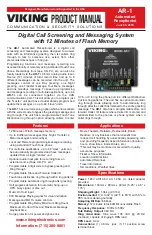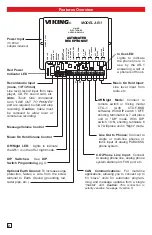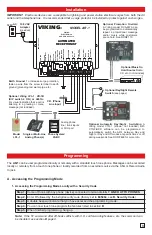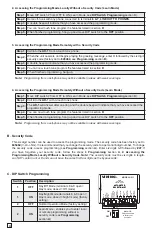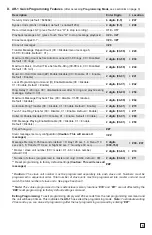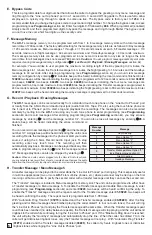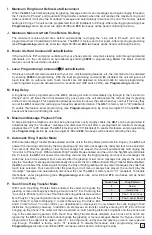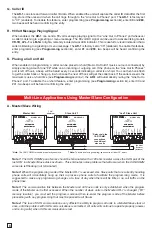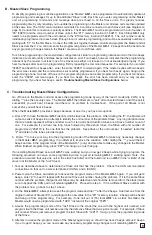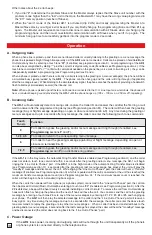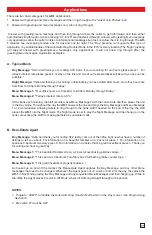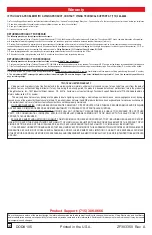
Go off hook on the Master unit and access the programming mode by way of the “learn” mode (dip 2 ON) or by
dialing “*” plus the security code. The Master
AR-1
then attempts to “poll” all connected Slaves and if the poll is
successful, you will hear 2 beeps (and there is no problem to troubleshoot). If the poll of all Slaves is not
successful, you will hear 4 beeps.
When the Master
AR-1
provides 4 beeps because of an error, you have two options:
a. Dial a “#” to have the Master
AR-1
identify which slave has the problem. After dialing the “#”, the Master will
output a series of beeps in an attempt to identify the unit number of the problem Slave. Any long duration tones
that are heard represent a Slave number count of ten and short duration tones are a Slave number count of
one. For example, if you hear two long tones followed by three short tones, the Slave with unit number 23
programmed (“23#10”) is the one that has the problem. Keep track of the unit number. If needed, redial the
“#” and listen to the tones provided again.
b. Dial a “*” to force your way into the programming mode of the Master
AR-1
to make any necessary changes
in the Master
AR-1
programming, in an attempt to improve the situation. After dialing the “*”, you will hear 2
beeps and are in the program mode of the Master AR-1 (only) and are able to make any changes to the Master.
When finished programming, press “##7” and hang up or just hang up.
If an existing Master/Slave set-up of
AR-1
’s was working and you now get 4 beeps while trying to program, the
following procedure can save some programming time, to get all remaining
AR-1
’s working again.
Note: This
procedure assumes that only one unit in the stack has failed and the failed unit is an
AR-1
in the “middle” of the
stack (not the Master or the “last” Slave).
1. Test as described above to determine the Slave unit that has the problem. Check the CAN communication
connections on that unit on screw terminals 2 (CANL) and 3 (CANH).
2. Power cycle the Slave and attempt to access the program mode of the Master
AR-1
again. If you still get 4
beeps, enter “#” to see if it replies with the same Slave unit number having the problem. If it is the same Slave
number with the problem, that particular Slave may be defective and should be removed from the stack (make
sure to bypass the CAN pair to all remaining
AR-1
’s). Proceed to step 3. If it is a different Slave number with
the problem now, go back to step 1 above.
3. On the Master
AR-1
, attempt to access the program mode and dial “*” after the 4 beeps. Subtract one from the
original number of Slaves (#11) and program the new value in the “#11” memory location. 2 beeps will be heard
and hang up from programming. For example, if one unit out of (16) total
AR-1
’s in a stack has failed, the
Master would now be programmed with “14#11” instead of the original “15#11”.
4. Access the programming mode of the “last” Slave in the stack (the one with the highest unit number) and
program it with the Slave unit number used by the defective Slave that was just removed. For example, if Slave
unit number 12 was just removed, program the last Slave with “12#10”. Hang up from the programming mode
of the Slave.
5. Attempt to access the program mode of the Master again and you should now hear 2 beeps versus 4 beeps.
If you do get 2 beeps, you can now make any necessary programming changes to all remaining
AR-1
’s.
9
To simplify programming in multi-line applications, one “Master”
AR-1
can be programmed to automatically update all
programming and messages for up to 63 additional “Slave” units. Each time you enter programming on the Master
unit, all programming commands and message data are echoed to all the Slave units. This greatly reduces
programming time by only requiring you to update the programming on the Master unit. All slave units are then updated
at the same time. The CAN communications terminals 2 & 3 must be connected to each slave unit (see diagram on
page 8). Caution this connection is polarity sensitive. The Master
AR-1
must be programmed with a unit number of
“00” (00#10) and the correct number of slave units in the “#11” memory location (01-63#11). Each Slave
AR-1
only
needs to be programmed with the unit number in the “#10 memory location (01-63#10). The unit number must be
individually programmed into each slave (through local or remote programming) and must be sequentially numbered,
starting with “01” for the first Slave. Connect the CAN pair together between all units and program the Master and all
Slaves as described. You can now enter the programming mode of the Master
AR-1
. 2 beeps should be heard and
any programming changes made in the Master are also sent to all Slave units.
Touch tone programming in the master/slave configuration is similar to programming individual units in that two beeps
indicates a successful entry and three beeps indicates an error. Four beeps, however, indicates that the programming
data sent by the master to at least one of the slaves was either not received or not acknowledged properly. If you
hear four beeps after an entry in programming, first try repeating the command sequence. For example if you entered
“03#50” and heard four beeps after, enter the entire “03#50” command again. If the master replies with two beeps,
the error was cleared and the command was successfully programmed. If you hear four beeps again, hang up the
programming phone. Go back off hook on the programming phone and enter programming. If you hear two beeps,
enter the “03#50” command again. If you hear two beeps, the error has been cleared and you may resume
programming. If you hear four beeps, see
C. Troubleshooting Master/Slave Configurations
below.
B. Master/Slave Programming
C. Troubleshooting Master/Slave Configurations

